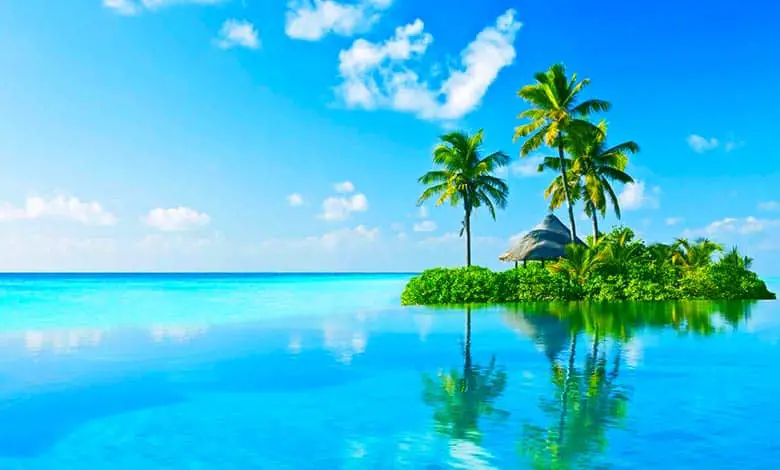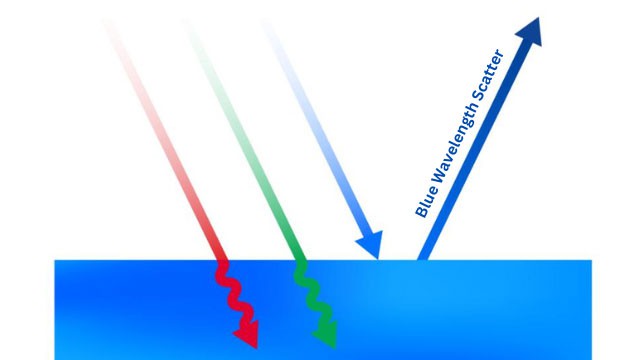
Have you ever wondered why you’ve looked at an enormous expanse of water, a lake, or an ocean that appears very blue? Sometimes beautifully blue, like in Cuba or Jamaica, where the beaches are lovely white sand, and the water is beautiful. But then, if you take that water and cup it in your hands, it’s not blue. It’s crystal clear! If you have ever wondered why that is, the answer lies in water’s chemical & physical structure.
Ever stood at the edge of the ocean, gazing into the horizon, and found yourself mesmerized by the vast expanse of blue? It’s a scene as timeless as the earth itself, yet the question of why the sea appears blue remains a source of wonder and curiosity for many. This blue mystery is not just a matter of aesthetics but a fascinating scientific story that unfolds at the intersection of light, water, and the very molecules that compose our planet’s lifeblood.
In this post, we’ll dive deep beneath the surface of casual observation to explore the depths of why the sea is blue. From the way sunlight dances on the water’s surface to the hidden world beneath the waves, prepare to embark on a journey that will change the way you see the ocean’s azure beauty.
Why Is The Sea Blue?
The sea appears blue because of a combination of factors related to the interaction of light with water. Here’s a simplified explanation of why the sea appears blue:

Absorption and Scattering of Light: When sunlight enters the ocean, it interacts with water molecules. The water absorbs and scatters different wavelengths of light to varying degrees. This absorption and scattering process is influenced by the molecular structure of water and its impurities or particles.
Absorption of Longer Wavelengths: Water absorbs longer wavelengths of light, such as red, orange, and yellow, more strongly than shorter wavelengths, such as blue and green. The absorbed longer wavelengths do not reach our eyes, contributing to the ocean’s perceived blue color.
Scattering of Shorter Wavelengths: While water absorbs longer wavelengths, it scatters shorter wavelengths, mainly blue and green. The scattering of shorter wavelengths is more efficient and widespread in the ocean, resulting in a significant amount of blue light being scattered and reaching our eyes.
Depth of the Ocean: The depth of the water also influences its color. In shallow waters, where the light can reach the seafloor, the color of the seabed and particles suspended in the water can affect the overall color appearance. In deeper waters, the scattered blue light dominates the visual perception.
Reflection of the Sky: The color of the sky can also contribute to the blue appearance of the sea. The sky acts as a backdrop and reflects its blue color onto the water’s surface, enhancing the overall blue perception.
The ocean is blue because light interacts with the water as light travels from the sun through the water. It either gets absorbed by particles or is scattered. As the light travels, it gets attenuated, which is a fancy word for as you go deeper into the water, more and more light is lost to absorption. The reason that absorption affects the color of the water is that different wavelengths of light are absorbed at various rates.
So, red light, which is longer and has slower wavelengths, is more likely to hit a particle. Therefore is attenuated faster than blue and green light. Also, blue and green light travels deeper into the water, giving it its blue color. This light is absorbed as it travels through the water, explaining why tropical waters are a very different color, blue, then temperate waters.
This is because tropical waters have very low productivity, whereas temperate waters have very high productivity. It means there is much dissolved organic matter in the water and plankton. These two things give the light many more particles to hit and be absorbed. It means the light gets absorbed and attenuated much more quickly in temperate waters than in tropical waters.
Therefore, tropical waters are a lot bluer because there is more light. Tropical waters are also much shallower, so the light travels to the bottom. It also reflects the white-colored sand. So thus, the light traveling through the water not only explains why the ocean is blue. But why do different parts of the sea appear to be different colors of blue?
Blue Sea Explanation by Physics
The shorter wavelengths of light on the blue end of the spectrum can pass through. But the longer wavelengths of light on the red end of the spectrum can not pass through. When white light containing all the rainbow colors passes through, only the blue wavelengths come out the other side, and the gel looks blue.
Blue wavelengths travel much better through water than red wavelengths. Light travels into the water and down to the bottom of the sea. The light that reaches the bottom has a much less red wavelength than the light at the surface. The light reflects off the bottom and travels back to the surface to reach our eyes. There is even less red. So the water looks even bluer.
If you look at the ocean, the water is deeper, so the bottom is further down. The light travels further before reflecting off the bottom and returning up, making the blue more prominent. In bottomless water, it appears quite a deep blue. The water is blue, but it takes a lot of water to see the color.
Why does some water look green? If the ocean has many plankton, the green hue caused by the plankton is much stronger than the soft blue color. So, the blue is overpowered by the green. The blue color of ocean water makes underwater filming tricky because the light down there doesn’t have a lot of red. Even things brightly colored with reds or yellows don’t look that way to our eyes or camera.
Blue Ocean Explanation by Chemistry
A large body of water appears blue because it absorbs red light due to its chemical structure. When a photon with the amount of energy that makes it red hits a water molecule, it’ll absorb and allow the water molecule to vibrate with its OH bonds at a more excited state. The result is that you see the water looking blue.
Why don’t you see that it doesn’t look blue when you cup your hands and hold water in your hands? It’s because it’s not enough water. The effect is not visible in small water quantities, like the amount of water you hold in your hands. Here’s a neat fact: if you took a gallon of water stretched it out into a long, thin tube, and looked through the tube at one end, the water would look blue because you’re looking through enough water to get that effect.
Some other factors can influence the effect.
- The reflection of the blue color from the sky on the water.
- The scattering of blue light from particles.
It might be suspended in the water like runoff from glaciers or things like that. When you see a large body of water that appears very blue, its chemical structure causes it to absorb red light, leaving the water blue. If you have any other questions about the ocean, leave them in the comments below.
Learn More:
References:
“What’s the difference between an ocean and a sea?”. Ocean facts. National Oceanic and Atmospheric Administration.
Stow, Dorrik. Encyclopedia of the Oceans. Oxford University Press.
Nishri, A.; Stiller, M; Rimmer, A.; Geifman. “Lake Kinneret (The Sea of Galilee): the effects of diversion of external salinity sources and the probable chemical composition of the internal salinity sources.” Chemical Geology.
Conforti, B.; Bravo, Luigi Ferrari. The Italian Yearbook of International Law, Volume 14. Martinus Nijhoff Publishers.
Karleskint, George; Turner, Richard. Introduction to Marine Biology. Cengage Learning.
American Society of Civil Engineers (eds.). The Glossary of the Mapping Sciences. ASCE Publications.

